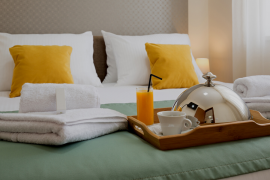In recent years, the popularity of Poke has reached an all-time high. Poke is raw fish seasoned with various spices and served over rice with other toppings based on personal taste. Previously, Poke was limited to the Hawaiian Islands, but it is now popular across the United States and has been one of the fastest growing culinary trends in recent years. Basically, Poke is the deconstruction of Sushi and allows the consumer to pick and choose what they like rather than be forced to choose a predetermined sushi roll. But what does this have to do with the hotel industry? Let me see if I can explain.
Hotel and Airline Similarities
The airline industry and the hotel industry share many characteristics including high capital costs, relatively low variable costs, fixed capacity, perishable inventory, and varying demand (Cross, Higbie, & Cross, 2009; Hanks, Cross, & Noland, 2002). It is these characteristics that led the hotel industry to recognize and mimic the airline industry in implementing rudimentary methods of revenue management (RM) in the early 1980s (Kimes, 2003), and RM continues to develop into a sophisticated process of maximizing revenues. However, the airline industry has recently added to the more traditional method of RM by allowing the consumer to book a reservation at a base price and then choose ancillary services and features based on consumer preferences, for additional fees (Garrow, Hotle, & Mumbower, 2012). This relatively new approach to RM in the airline industry has been successful in generating supplementary revenue where some airlines are seeing as much as 40% of total airline revenues generated through ancillary charges (de Wit & Zuidberg, 2012; Wittmer & Rowley, 2014). Furthermore, the method of pricing has increased the profitability of airlines.
Initially, it was thought this approach would lead to customer service issues and the expectation that airlines, not considered low-cost carriers, might move away from charging ancillary fees (Garrow et al., 2012), but it appears that it is a trend that is here to stay and may actually improve customer satisfaction. A study by Kurtulmusoglu, Can, & Tolon (2016) found the type of airline most preferred, with the highest confidence rate, is a low-cost carrier airline which allows passengers to choose additional services for additional charges. The reality is that although people like to complain about being nickel and dimed, their desire for a perceived “deal” is more important and therefore, preferred.
The Direction of Revenue Management and A La Carte/Ancillary Pricing
Over the years revenue management has changed from being concerned with maximizing revenue from one source (per seat revenue in airlines or revenue per available room in hotel) to total revenue maximization with a focus on consumer preferences (Cross, Higbie, & Cross, 2009).With this focus on total hotel revenues, the ability to charge for ancillary services (either previously included in the base price of a room or for additional services) should be attractive to hotel operators as they seek increase profitability. This type of pricing is known as unbundling, a la carte pricing (Tuzovic, Simpson, Kuppelwieser, & Finsterwalder, 2014), or ancillary pricing.
Ancillary charges in the airline industry consist of unbundled products and services previously included in the base price, additional services not previously included, and third-party commissions. Examples of unbundled services include baggage fees, fees charged for snacks and drinks previously included, seat selection, reservation changes, etc… (O’Connell & Warnock-Smith, 2013). Similar unbundled characteristics in hotel might be, portage fees, in room coffee, specific types of pillows or linen, additional towels, or rooms with different bed options, all of which have historically been included in base pricing.
Additional services in the airline industry included products and services including seat upgrades, high speed in-flight and airport internet access, airline club lounge access, priority boarding, upgraded food and beverage options, and additional baggage fees among others (O’Connell & Warnock-Smith, 2013, Wittmer & Rowley, 2014). Hotel offerings might include size of room offering, guest club lounge access, robes and slippers, view rooms, upgraded bedding, or any other item deemed important or desired by the consumer. With a hotel environment being larger than that of a plane and the duration spent at a hotel being greater than that spent on an airline, more options exist and therefore, more opportunities to increase revenue.
The Justification for Unbundling
Unbundling seeks to improve customer’s perceptions of price fairness by increasing transparency (Ferguson, 2014), and determining what they perceive important for increasing their personal utility based on individual preferences, needs, or wants (Granados, Kauffman, Lai, & Lin, 2012). Consumers prefer uniqueness (Azevedo, 2009), creating memories (Jackson & Qu, 2008), individualized/personalized service (Olga, 2009), and layering an additional service on top of an existing service to create memories (Chun Wang, Wang, & Tai, 2016) further indicating that allowing a consumer to pick specific items in a hotel that are important to them will increase guest satisfaction.
During the pandemic over the last couple of years, services in the hotel industry were cut back dramatically and many items previously included in a hotel stay were eliminated or provided upon request only. The hotel industry’s ability to monetize those requests may very well be the answer to offsetting the rising costs of supplies and wages. A la carte pricing may not only become the preferred method of pricing in hotels, but it may also be necessary to keep the hotel industry profitable.
Practical Application
Think about the cost savings that could be incurred by providing only one towel, one pillow, and no toiletries because a guest only plans on staying one night and prefers to bring their own. Or imagine the opposite, being able to charge for multiple sets of those same items at a marked-up price over what it cost to provide them. Cost savings would be realized not only in purchasing less amenities, but also the labor savings in preparing a guest room. Furthermore, think about the perception from the guest and being able to “save” money by not having to pay for those unwanted or unnecessary amenities. Imagine being able to charge for access to a priority lounge instead of giving it away complimentary. Or envision the initial investment savings by only needing to purchase half of the linen previously required upon opening a hotel among other supplies.
Many might argue that this issue is addressed naturally by the segmentation of hotels, but I would argue that this principle could work in any classification of hotel. A select service hotel like a Holiday Inn Express still provides complimentary breakfast, in-room coffee, a iron and ironing board, multiple sets of towels and pillows and check in service. A luxury hotel provides all those same items, but also access to recreational activities, multiple dining options, bathrobes, slippers, and turndown service. Just because I may prefer staying at a Ritz-Carlton instead of a Fairfield Inn, does not mean that I want to pay for more than I need or use. As a business traveler, why would I want to pay for the use and maintenance of a pool or why would a leisure traveler want to pay for a business center. Instead, depending on my purpose of travel it seems I would be willing to pay for those items that will create the greatest joy or productivity on my trip. In fact, it seems unequitable to have someone staying in a room with 5 people, eating 5 breakfasts, using 5 sets of towels, and using considerably more shampoo, soap, and lotion to pay the same amount of as a person traveling for business who arrives at 10 pm and leaves at 6 am without eating breakfast at all.
Lessons to be Learned
History has taught us that those companies who refuse to change will likely become obsolete. The airline industry was forced to approach revenue management in a whole new light because so many airlines were either forced into, or were on the brink of, bankruptcy. The hotel industry has historically managed its profitability better than the airline industry and this may be the reason that the hotel industry has been hesitant to adopt true a la carte pricing. However, over the last two years of operating hotels during a global pandemic, we learned that guests would accept a new normal whether that be mobile check in, prepackaged breakfast items, or weekly cleaning.
Too often companies are hesitant to be the first to adopt a paradigm shift, instead wanting to let someone else be the guinea pig. However, we saw a brief glimpse during the pandemic of how vulnerable the hospitality industry can be. Had there been another significant world-wide event that negatively impacted hotels on the heels of the pandemic, it is likely that very few hotel companies would have survived. Those that have a lower cost model will undoubtedly weather the financially challenging times better than those who do not. Unbundling, a la carte, or ancillary pricing provides a model to insulate the hotel industry against economic fluctuations and can provide guests with a sense of personalization and value.
Sure, there will always be those who prefer sushi, but there is a reason that Poke is one of the fastest growing food trends in America. People like to choose what they consume and are willing to pay for those items that they feel will give them the most utility or enjoyment. Why should hotels be any different?
References
Azevedo, A. (2009). Designing Unique and Memorable Experiences: Co-creation and the “Surprise” Factor. III Congresso Internacional de Turismo de Leiria E Oeste – 2009, 3(2007), 42–55.
Chun Wang, J., Wang, Y.-C., & Tai, Y.-F. (2016). Systematic review of the elements and service standards of delightful service. International Journal of Contemporary Hospitality Management, 28(7), 1310–1337. https://doi.org/10.1108/IJCHM-08-2014-0400
Cross, R. G., Higbie, J. A., & Cross, D. Q. (Dax). (2009). Revenue management’s renaissance. Cornell Hospitality Quarterly, 50(1), 56–81. https://doi.org/10.1177/1938965508328716
de Wit, J. G., & Zuidberg, J. (2012). The growth limits of the low cost carrier model. Journal of Air Transport Management, 21, 17–23. https://doi.org/10.1016/j.jairtraman.2011.12.013
Ferguson, J. L. (2014). Implementing price increases in turbulent economies: Pricing approaches for reducing perceptions of price unfairness. Journal of Business Research, 67(1), 2732–2737. https://doi.org/10.1016/j.jbusres.2013.03.023
Garrow, L. A., Hotle, S., & Mumbower, S. (2012). Assessment of product debundling trends in the US airline industry: Customer service and public policy implications. Transportation Research Part A: Policy and Practice, 46(2), 255–268. https://doi.org/10.1016/j.tra.2011.09.009
Granados, N., Kauffman, R. J., Lai, H., & Lin, H. C. (2012). À La Carte Pricing and Price Elasticity of Demand in Air Travel. Decision Support Systems, 53(2), 381–394. https://doi.org/10.1016/j.dss.2012.01.009
Hanks, R., Cross, R., & Noland, P. (2002). Discounting in the hotel industry. Cornell Hotel and Restaurant Administration Quarterly, (August), 94–103. https://doi.org/10.1016/S0010-8804(02)80046-5
Jackson, L. a., & Qu, H. (2008). A Conceptual Framework for Managing Lodging Brands: A Balanced‐Scorecard Approach. Journal of Quality Assurance in Hospitality & Tourism, 9(2), 108–134. https://doi.org/10.1080/15280080802235458
Kimes, S. E. (2003). Revenue Management : A Retrospective Revenue Management : A Retrospective, 44, 131–138.
Kurtulmusoglu, F. B., Can, G. F., & Tolon, M. (2016). A voice in the skies: Listening to airline passenger preferences. Journal of Air Transport Management, 57, 130–137. https://doi.org/10.1016/j.jairtraman.2016.07.017
O’Connell, J. F., & Warnock-Smith, D. (2013). An investigation into traveler preferences and acceptance levels of airline ancillary revenues. Journal of Air Transport Management, 33, 12–21. https://doi.org/10.1016/j.jairtraman.2013.06.006
Olga, A. (2009, September). The alternative hotel market. In Management Science and Engineering, 2009. ICMSE 2009. International Conference on(pp. 2021-2025). IEEE.
Tuzovic, S., Simpson, M. C., Kuppelwieser, V. G., & Finsterwalder, J. (2014). From “free” to fee: Acceptability of airline ancillary fees and the effects on customer behavior. Journal of Retailing and Consumer Services, 21(2), 98–107. https://doi.org/10.1016/j.jretconser.2013.09.007
Wittmer, A., & Rowley, E. (2014). Customer value of purchasable supplementary services: The case of a European full network carrier’s economy class. Journal of Air Transport Management, 34, 17–23. https://doi.org/10.1016/j.jairtraman.2013.07.002
















